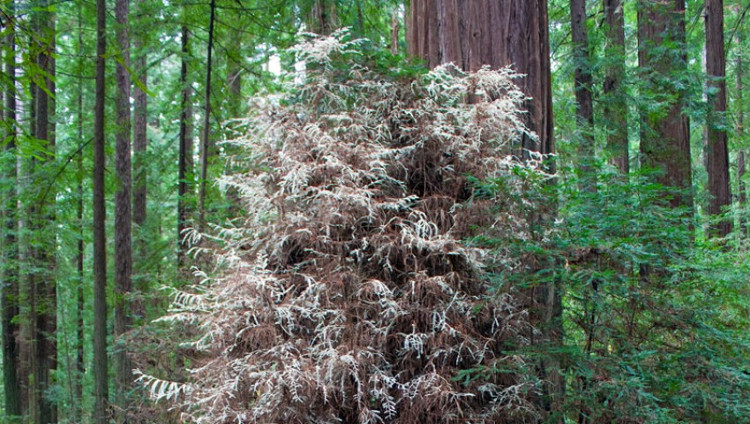Mysterious ghost tree does not need photosynthesis in the American forest
The secret of the photosynthesis survival of albino "ghost" in the forests of California, USA, has been a big question for scientists for a century.
Albino rosewood in a coastal forest in California, USA, dubbed the "ghost tree" by the distinctive color of the trunk. This plant lacks chlorophyll, a blue pigment that helps plants photosynthesize from sunlight. "It should have died, but it still exists like a ghost," said biologist Zane Moore, a doctoral student at the University of California, Davis.
The mystery of albino rosewood confused researchers for more than a century. This tree is so dim that if one does not look close, many people may suspect they do not really exist. However, Moore thinks there is a scientific explanation for the existence of trees as well as the entire forest.
Previously, almost no scientist could study albino rosewood . Albino plants are extremely rare. According to Moore's latest record, the number of albino trees in the world is only 406. The genome of the plant has 32 billion base pairs compared with 3.2 billion in humans and each chromosome has 6 copies. Why instead of two. Researchers have not been able to sequence the rosewood genome and have not yet found a mutation that makes albino plants.

An albino rosewood in California forest.(Photo: Outside Online).
Rosewood can replicate itself . Plant layers in close proximity communicate through the roots. During the harsh winter and early spring months, they share all the nutrients together. Scientists pour dyestuffs into plants on a grove and monitor dyes that spread through the network of roots to the other end.
This cooperation lasts only until the summer. After that, each tree, branch and shoot must exist on its own. Plants that cannot photosynthesize are removed from the root-sharing nutrient system and die in the fall. Moore explores how albino rosewood benefits from the system by sucking in sugar produced by healthy surrounding plants."Many people believe that albino rosewood is a parasite and even call it a" vampire tree. "However, rosewood lives in a smarter way," Moore said.
Moore and his colleague, plant specialist Tom Stapleton, decided to document the location of each recorded albino rosewood. Their map shows that albino trees often grow in areas with less favorable conditions and environmental pressures can spur mutations. Later, Moore sought to collect specimens from albino trees and healthy neighboring trees along the coastal California.
Moore discovered albino leaves that were filled with a mixture of cadmium, copper and nickel. On average, each white needle contains twice as much toxic heavy metal as green needles in normal plants. Moore thinks that the problem lies in the stomata, pores that allow plants to absorb water. Rapidly dehydrated plants were forced to suck more water, meaning albino trees had twice as much heavy metal water flowed through the trunk as healthy trees.
"It seems that albino trees suck heavy metal from the soil. They are poisoning themselves," Moore said.
Moore examined the most poisonous albino rosewood with 10 times more nickel than healthy plants. In a report published next year, Moore identified albino rosewood as symbiotic relations with the same species. They act as a repository for toxins in exchange for the amount of sugar needed to survive.
Moore intends to delve into this phenomenon. His next experiment was to pump nickel into rosewood, green leaf and albino grown in the laboratory to see if the plants growing with albino trees grew healthier. He also wanted to check if the heavy metal in albino trees remained in the tree or absorbed into the soil. If the hypothesis proves correct, Moore hopes in the future it is possible to plant albino rosewood in polluted areas to make soil safer for other plants.
- The mysterious village 'appears' in the middle of the ghost forest in the sea
- The most exotic trees on Earth
- The mysterious 2000-year-old
- Ghost images of the world famous
- Thousands of years old oak forest revealed after the storm
- Ghost hunting technology
- Mystery of 2000 year old ghost forest
- The bird is dubbed 'ghost forest', has a 'jackpot' crest
- Chernobyl: The 30-year exotic forest doesn't decompose
- Discovering a 10,000-year-old mysterious forest in the deep sea
- Mysterious ghost ships (part 2)
- Mysterious ghost ships (part 1)
 Why do potatoes have eyes?
Why do potatoes have eyes? 'Tragedy' the world's largest carnivorous life: Death becomes ... public toilet
'Tragedy' the world's largest carnivorous life: Death becomes ... public toilet Tomatoes were once considered 'poisonous' for 200 years
Tomatoes were once considered 'poisonous' for 200 years Detecting microscopic parasites on human face
Detecting microscopic parasites on human face